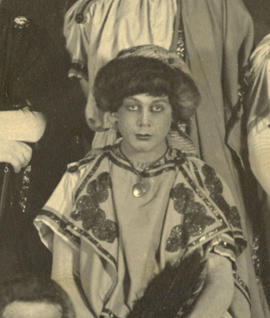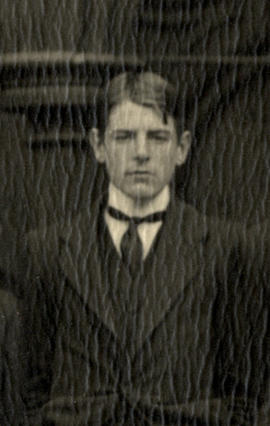Dulley, Hugh William Macpherson, brother of John Herbert Macpherson Dulley (q.v.); b. July 11, 1903; adm. as K.S. Sept. 27, 1917; left Aug. 1922; in the employment of Messrs. Gibbs and Co. at Valparaiso, Chile 1925-30, and with Messrs. Jardine Matheson & Co. at Hongkong 1930; rowed no. 3 in the English Eight at the Olympic Games at Paris 1924; Sub-Lieut. Hongkong Royal Naval Volunteer Force Dec. 1935; Lieut. Dec. 1936; Lieut.-Cdr. June 1940; m. Nov. 23, 1936, Therese, elder daughter of Max Sander, of Hull; killed in action at Hong Kong Dec. 1941.
Hugh William Macpherson “Peter” Dulley was born at Wellingborough, Northamptonshire on the 11th of July 1903 the son of Herbert Dulley, a brewer, and Agnes Leonora (nee Macpherson) Dulley later of 5, King’s Bench Walk, Inner Temple in London. He was christened at All Hallows Church, Wellingborough on the 8th of November 1903.
He was admitted to Westminster School as a resident King’s Scholar from the 27th of September 1917 to August 1922 and was appointed as head of the King’s Scholars in September 1921. He was also appointed as a Monitor in September 1921 and was appointed as Editor of the Elizabethan in the same month. He was a member of the 1st Rowing VIII in 1921, where he rowed at bow, and was appointed as Head of The Water in the same year. In 1922 he rowed at stroke and the Elizabethan wrote the following on his 1922 season: - “A very good all round oar with one or two rather bad faults. As a stroke he has done excellent work, showing splendid judgement, and an inexhaustible supply of energy. It will be a difficult to find a substitute possessing his peculiar faculty of being able to size up the opposing crew during the course of a race.”
He was a member of the Officer Training Corps and was promoted to Company Sergeant Major in September 1921.
He was a member of the Thames Rowing Club from a young age and won the Junior Sculls at the Reading Regatta of 1923. He rowed at No. 3 in the Great Britain Rowing VIII at the 1924 Paris Olympics where the crew finished in fourth place by half a length. He embarked at Liverpool on board the SS Oroya on the 22nd of January 1925 bound for Chile where he went to work for Messrs. Gibbs and Company at Valparaiso from 1925 and later returned to London. He was appointed as Head of the Water for The Old Westminster Boat Club in 1929, a position from which he resigned in 1930 when he went abroad once again.
He set sail from London on board the SS Rawalpindi on the 24th of January 1930 bound for Hong Kong where he joined the staff of Messrs. Jardine Matheson to work as a clerk. He was a keen sailor and was commissioned as a Sub Lieutenant in the Hong Kong Naval Volunteer Reserve in December 1935. He was promoted to Lieutenant on the 2nd of December 1936. He was married on the 23rd of November 1936 to Therese (nee Sander) of Tonbridge, having met her on New Year’s Eve the previous year. They lived at Victoria in Hong Kong. Eight months pregnant, Therese was evacuated to the Philippines in July 1940 where she had a son, Hugh OW, born on the 25th of July 1940. They later sailed to Australia, stopping briefly at Hong Kong en route.
He served on board HMPS Perla from 1939 and was based at the Royal Navy base HMS Tamar III in Hong Kong in 1941. In November 1941 he was posted to the sloop/drillship HMS Cornflower, the Headquarters of the Hong Kong Naval Volunteer Force. The ship was moored to the south west of Kellett Island, close to the Royal Hong Kong Yacht Club, of which many of its recruits were members. In August 1939 the Hong Kong Naval Volunteer Force was merged with the Hong Kong Naval Volunteer Reserve giving it a total strength of one hundred and ten officers. Peter Dulley was placed in command of a 500 ton ocean going tug and successfully sailed it to Aden in spite of his inexperience. He was promoted to Lieutenant Commander on the 15th of June 1940.
On the morning of the 8th of December 1941, the Japanese launched an attack across the Chinese border into the New Territories and advanced towards the island of Hong Kong. On the evening of the 18th of December their forces crossed the Lye Mun Pass and landed on the island where they had established a strong beachhead by the following morning. In the early hours of the morning of the 19th of December the commanding officer of the Hong Kong Royal Naval Volunteer Reserve, Commander Vernall, received an urgent telephone call from the 1st Battalion, Middlesex Regiment requesting that a naval patrol be sent to investigate reports of fifth columnists signalling from Postbridge House at the top of Repulse Bay. At 5am a party led by Hugh Dulley set off in a truck from their base at Deep Water Bay and travelled up the Repulse Bay Road to the Wong Nei Chong Gap where they arrived at the driveway leading to Postbridge House at 5.20am. They reached the house to find it occupied by members of the Royal Artillery. Hugh Dulley, assuming they had gone to the wrong house, decided to check another nearby house and led his men towards their truck. As they went back down the driveway they saw shadowy figures and heard voices just before a hand grenade was thrown towards their party which caused no casualties. Thinking that he may have run into a Canadian unit he shouted at them; this was followed by a burst of machine gun fire. The group scattered and made their way back to Postbridge House where, at 6.30am, they saw enemy troops digging in around the building on the surrounding slopes. Having had their communications with the outside world cut, they exchanged fire with the Japanese with Hugh Dulley taking up a position at a window in an upstairs room from where he sniped at the enemy troops. By 10.45am the defenders were running low on ammunition but a telephone line had been established and reinforcements were requested to be sent to relieve them. They were reached by a few reinforcements at around noon who brought three machine guns and 15,000 rounds of ammunition. During the afternoon the Japanese began to work their way around the building and those defenders who were positioned at the garden wall were ordered to fall back to the house. Towards evening a small party of Japanese managed to get close enough to the house to lay explosive charges against the building. A short time later there was a massive explosion which blew out all of the windows, demolished the stairwell and started a number of fires in the building which illuminated the defenders. This was followed by heavy fire from enemy machine guns with grenades being thrown into the house. Hugh Dulley was killed at this time and with the situation now considered to be untenable, the order was given to evacuate the building under the cover of darkness.
He was Mentioned in Despatches, which was announced in the London Gazette of the 2nd of July 1945.
He was the author of “A Voyage to War”, which was published by his son in 2016.
He is commemorated on the Plymouth Naval Memorial Panel 96, Column 3.

